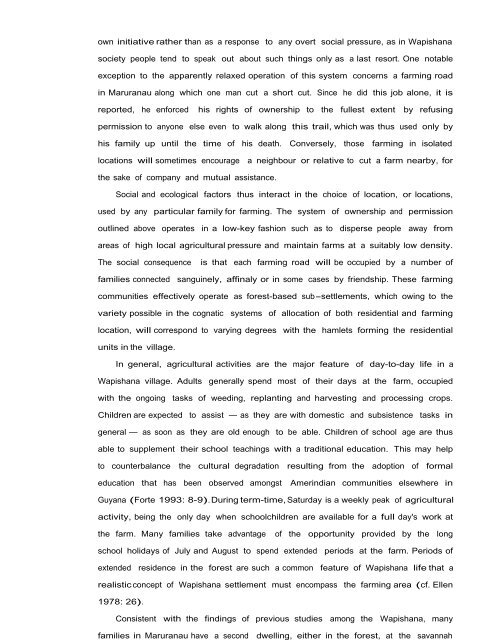Ethnoecology, Resource Use, Conservation And Development In A ...
Ethnoecology, Resource Use, Conservation And Development In A ...
Ethnoecology, Resource Use, Conservation And Development In A ...
You also want an ePaper? Increase the reach of your titles
YUMPU automatically turns print PDFs into web optimized ePapers that Google loves.
own initiative rather than as a response to any overt social pressure, as in Wapishana<br />
society people tend to speak out about such things only as a last resort. One notable<br />
exception to the apparently relaxed operation of this system concerns a farming road<br />
in Maruranau along which one man cut a short cut. Since he did this job alone, it is<br />
reported, he enforced his rights of ownership to the fullest extent by refusing<br />
permission to anyone else even to walk along this trail, which was thus used only by<br />
his family up until the time of his death. Conversely, those farming in isolated<br />
locations will sometimes encourage a neighbour or relative to cut a farm nearby, for<br />
the sake of company and mutual assistance.<br />
Social and ecological factors thus interact in the choice of location, or locations,<br />
used by any particular family for farming. The system of ownership and permission<br />
outlined above operates in a low-key fashion such as to disperse people away from<br />
areas of high local agricultural pressure and maintain farms at a suitably low density.<br />
The social consequence is that each farming road will be occupied by a number of<br />
families connected sanguinely, affinaly or in some cases by friendship. These farming<br />
communities effectively operate as forest-based sub-settlements, which owing to the<br />
variety possible in the cognatic systems of allocation of both residential and farming<br />
location, will correspond to varying degrees with the hamlets forming the residential<br />
units in the village.<br />
<strong>In</strong> general, agricultural activities are the major feature of day-to-day life in a<br />
Wapishana village. Adults generally spend most of their days at the farm, occupied<br />
with the ongoing tasks of weeding, replanting and harvesting and processing crops.<br />
Children are expected to assist — as they are with domestic and subsistence tasks in<br />
general — as soon as they are old enough to be able. Children of school age are thus<br />
able to supplement their school teachings with a traditional education. This may help<br />
to counterbalance the cultural degradation resulting from the adoption of formal<br />
education that has been observed amongst Amerindian communities elsewhere in<br />
Guyana (Forte 1993: 8-9). During term-time, Saturday is a weekly peak of agricultural<br />
activity, being the only day when schoolchildren are available for a full day's work at<br />
the farm. Many families take advantage of the opportunity provided by the long<br />
school holidays of July and August to spend extended periods at the farm. Periods of<br />
extended residence in the forest are such a common feature of Wapishana life that a<br />
realistic concept of Wapishana settlement must encompass the farming area (cf. Ellen<br />
1978: 26).<br />
Consistent with the findings of previous studies among the Wapishana, many<br />
families in Maruranau have a second dwelling, either in the forest, at the savannah


